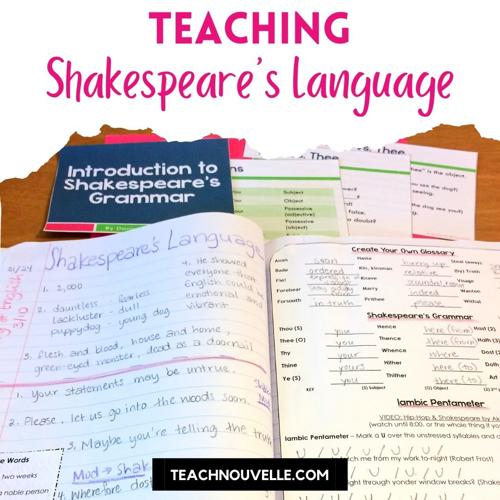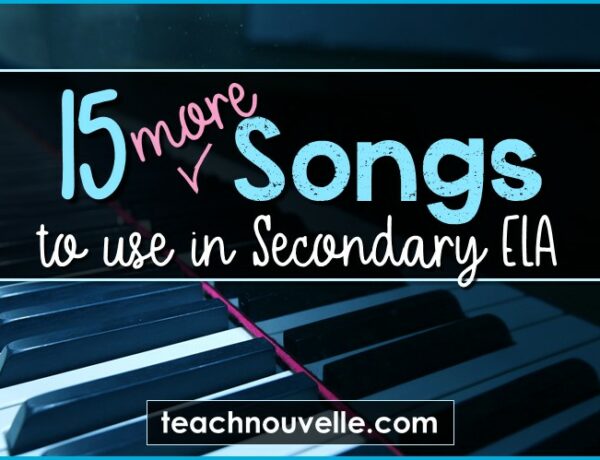Help students understand and engage with Shakespeare’s Language with these activities on vocabulary, grammar, and rhythm.
1. Thou & You: Rank and Emotion
My students know well in advance that I love teaching Shakespeare and drama, so they’re a little surprised when they confront Shakespeare’s language. They always assume I’m some sort of super genius if I can possibly understand that.
Who could possibly understand all of those thous and wherefores and yons? Well, I’m not a super genius, but I can teach my students a few tricks to help them feel like geniuses.
One of the most important aspects of teaching Shakespeare’s language is helping students understand the meaning of thou and you.
Analyzing the use of pronouns in a play can tell students a great deal about the status of characters and about the relationships a character has to other characters. The balance of these relationships can evolve or shift from scene to scene (and sometimes during the same scene: that’s the most fun!).
Knowing how Elizabethan pronouns work will help understand and play characters more fully and effectively.
To start students off, it’s important to introduce the Elizabethan idea of peerage. This is essentially the concept of societal rank. A character’s rank and relationship to another character is what determines their pronoun usage.
Likewise, Shakespeare’s characters often show us whether they’re being respectful, subservient, or quarrelsome through their language! We can miss a lot of subtlety if we don’t understand these points.
Want to integrate more drama in your ELA classroom?
Check out Shakespeare in 30!
NOBILITY
Highest rank: Royal family including King, Queen, Duke, Duchess, Prince, Princess
2nd highest rank: Marquess and Marchioness
3rd highest rank: Earl and Countess
4th highest rank: Viscount and Viscountess
5th highest rank: Baron and Baroness
GENTRY
These classes had the right to be called Lord (Sir) and Lady (Mistress).
Knights
Esquires (Squires)
Gentlemen
Members of the clergy are often given more respect, but everyone else is essentially commoners.
“You”
People of equal higher status use YOU during formal meetings with each other. It conveys respect.
People of lower status always use YOU when addressing someone of higher status.
“Thou”
People of equal higher status use THOU during informal interactions with each other. It conveys intimacy.
People of equal higher status can use THOU as an insult. (Example: Tybalt to Romeo – “Thou art a villain”)
People of higher status use THOU when addressing people of lower status.
People of lower status use THOU when addressing equals.
Example
As with anything, the lines can also be given a sarcastic tone to convey mockery or disdain. At the beginning of As You Like It, Orlando uses ‘sir’ and ‘you’ with his brother, but is anything but respectful!
Take a look at this example from The Tempest. This is pulled from Shakespeare in 30: The Tempest and you can grab the FREE Close Reading here.
ANTONIO Where is the master, boatswain?
Boatswain You mar our labor. Keep your cabins. You do assist the storm.
GONZALO Good, yet remember whom thou hast aboard.
Boatswain Out of our way, I say.
SEBASTIAN A pox o’ your throat, bawling, blasphemous, uncharitable dog!
Boatswain Work you then!
ANTONIO Hang, cur! hang, you whoreson, insolent noisemaker!
Now, let’s walk through it. This is a great example to model with students because it comes from the very beginning of the play. All they need to know is that the ship is in a storm, and that there are nobles onboard. The crew is trying mightily to save the ship, and the nobles are getting in the way.
ANTONIO Where is the master, boatswain?
Boatswain You mar our labor. Keep your cabins. You do assist the storm.
Initially the Boatswain uses the correct pronoun for those above his station. He needs the passengers not interfere with the crews’ attempts to keep the boat from sinking. However, he also orders them around, so the nobles are offended anyway.
GONZALO Good, yet remember whom thou hast aboard.
Gonzalo reminds the Boatswain (a good man) to be good and remember who the passengers are (no less than the King!). He emphasizes this by using the pronoun thou.
Boatswain Out of our way, I say.
SEBASTIAN A pox o’ your throat, bawling, blasphemous, uncharitable dog!
When the Boatswain insists, Sebastian insults him and uses the respectful YOU in a highly ironic way. He does not mean to show respect to the Boatswain but to point out that the man is wrong to order them about.
Boatswain Work you then!
ANTONIO Hang, cur! hang, you whoreson, insolent noisemaker!
Knowing he’s in trouble but still needing to do his job, the actor playing the Boatswain has a choice: his “Work you then” can either be a kind of desperate plea or an angry bark.
Either way, Antonio also insults him and uses YOU ironically. Antonio (the Duke of Milan) is not saying “Hang” in a powerless, dismissive way (the way we might say “Go hang yourself”). Antonio is saying he will have the Boatswain hung for such insolence.
2. A brief overview of Shakespearean vocabulary
Students watch History of English 3/10 by ouLearn and answer some key questions. The video is great because it’s short and students can watch it two or three times. It has a light, playful tone that captures the feeling that I’d like my students to have about Shakespeare’s language, particularly when we’re reading A Midsummer Night’s Dream or Much Ado About Nothing.
3. Shakespearean Vocabulary
Students complete a glossary with Shakespearean vocabulary for some keywords using websites like Shakespeare’s Words and Haverling HS Language of Shakespeare. I always have students compare answers with each other and double-check any questions they may have. They also complete a translation activity of Shakespeare’s language in class or as homework.
4. Shakespearean Grammar
In addition to learning Shakespearean vocabulary, my students go through a PowerPoint explaining Shakespearean grammar and complete some interactive activities as they go. This helps them develop skills for decoding tough word orders as they move on to read the play.
5. Hip-hop & Shakespeare’s language
Students watch Akala’s amazing TED talk in which he compares the rhythms of iambic pentameter in Shakespeare’s language to that of hip hop.
The whole talk is about 20 minutes, but I generally ask students to watch up to 8:00 for the core of the lesson. Most students like to rewatch the whole talk at home.
Final Thoughts
Teaching Shakespeare’s language can be a daunting task, but isolating a few key concepts for students will really improve their comprehension and their “takeaways”. The difference between thou & you is a great example of a really productive lesson since it helps students understand characterization in Shakespeare.
You can find all of these activities about Shakespearean vocabulary and grammar here, in my online store.
Here are some additional resources for your Shakespeare unit:
✨ Song pairings for Romeo & Juliet
✨ Teaching Romeo & Juliet
✨ Teaching Shakespeare to ESL students
If you’d like to read more about how I use drama in ELA, check out Staged Readings and Improv Games.








No Comments